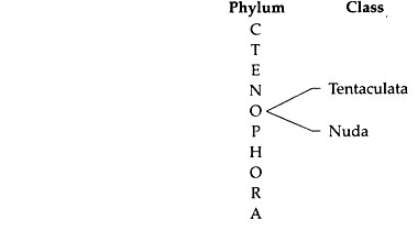Ctenophores (Greek for “comb-bearers”) feature eight “comb rows” of fused cilia arrayed along the sides of the animal, which can be seen clearly in these photos along the red lines. Ctenophores are propelled through the water by cilia that beat in unison. Some animals move by flapping their lobes or by undulating their bodies. Many ctenophores have two lengthy tentacles, however, some are completely devoid of tentacles.
Ctenophores are voracious predators known as comb jellies, sea gooseberries, sea walnuts, or Venus’s girdles. They lack stinging cells, unlike cnidarians, with whom they share numerous superficial similarities. Ctenophores, on the other hand, have sticky cells called colloblasts that help them catch prey. Special cilia in the mouth are utilized by a few species to bite gelatinous prey.
Ctenophore Bodies
The outer epidermis and inner gastrodermis are two layers of epithelial tissue that makeup ctenophore bodies. The mesoglea, a jelly-like layer of mesenchymal tissue, is sandwiched between these. True muscle cells are located in the mesenchyme and are grouped in longitudinal and radial fibers, providing the majority of body support and assisting in feeding motions. The exterior body of all comb jelly species bears eight plates of long, fused cilia, known as “ctenes,” at some time during their life cycle (typically at all stages). These ciliary bands are the principal mechanism of motility, and an apical sensory organ containing a calcareous statolith coordinates their beating.
Characteristics
- Habitat: These species are only found in the sea.
- This Phylum’s animals are solitary and free-swimming.
- They are diploblastic acoelomate creatures with a diploblastic body organization. A pair of long, firm, retractile tentacles protrude from the body, which is translucent, gelatinous, soft, and lacks segmentation.
- These organisms have bi-radially symmetrical bodies.
- Tissue: Tissue-level organization is present in these invertebrates.
- Comb rows are eight strands of cilia that let them move around. The movement is aided by these comb-like rows.
- They are hermaphrodite creatures, which means they reproduce through sexual means.
- External fertilization and indirect development are used by these species.
- They have an external as well as an intracellular digestive system.
- They have an aboral sense organ called the statocyst for balance. Nervous system: They have an aboral sense organ called the statocyst for balance.
- They don’t have separate organs for respiration and excretion, thus they rely on the body surface to carry out these functions.
- Size and shape range from microscopic Phylum Ctenophora spheroids (0.04 inch) to long (4.9 foot) ribbons. Ctenophora are lobe-shaped animals.
Classification

The Ctenophora Phylum is separated into two classes, as listed below:
Tentaculata
They have two tentacles with specialized sheaths and a tiny stomodaeum that can retract.
- Sea walnuts have a big mouth and eat mollusk larvae and copepods.
- Venus girdle is a flattened, ribbonlike Ctenophora that can be found in tropical waters.
- In sea gooseberries, secondary tentacles are smaller, and primary tentacles are reduced; secondary tentacles are smaller, and primary tentacles are reduced. On the Atlantic and Pacific coasts, these species are common.
- Sea Walnut, Sea Gooseberry, Venus Girdle, and other examples
Nuda
- Tentacles are not present in this class of animals.
- They eat jellyfish and other ctenophores and have largemouth.
- They are free-swimmers who can be found in all oceans and seas on the planet.
- Beroe, Mnepmiopsis, and other examples
Ctenophora Phylum’s Importance
The following are some of the economic and ecological implications of the Phylum Ctenophora:
Importance to the Economy
- While diving and snorkeling, they create wonderful views.
- Ctenophora’s genetics was one of their advantages. Ctenophores’ instantaneous luminescence is employed as a “biomarker” or “biotag.”
- Scientists employ them in studies to find activation genes by generating different glowing cats, mice, and other animals and observing whether the genetic changes made to these animals are effective.
Importance for the Environment
- They manage the plankton population underwater because they breed quickly and are good predators.
- They can be hungry and shrink when food is scarce, and they can adapt to higher temperatures, giving them an edge in shifting climatic conditions.
Conclusion
Phylum Ctenophora is a marine species that do not live in freshwater. They are mainly found at the ocean’s surface or in deep water. This species’ organisms are bi-radial symmetrical. Humans are unfamiliar with the animals in this Phylum.
Sea Walnut, Sea Gooseberry, Venus Girdle, and other animals found in this Phylum are examples of the animals found in this Phylum. Ctenophores manage the plankton population underwater because they reproduce quickly and are good predators.
 Profile
Profile Settings
Settings Refer your friends
Refer your friends Sign out
Sign out






